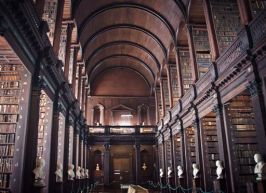
- Novel
- Modern literature
What It’s About
A Tale of Human Decency
What does it feel like to be suddenly cut off from nature and the world, beleaguered by an invisible bacillus and condemned to endless apathy? And, more importantly, what to do in such a nightmarish situation? Albert Camus, inspired by historical accounts of plague outbreaks and his experience during the Resistance in Nazi-occupied France, answered that timeless question in The Plague: Get up and do something useful together! The novel tells of a group of men who don’t even try to make sense of a meaningless disease, but instead establish hygiene standards, isolate and care for the sick, develop a cure and hope for the best. Like all pestilences, the plague eventually runs its course. But Camus warned his readers of complacency: Pathogens like totalitarianism, racism or mindless opportunism won’t disappear for good. We must rise up in collective action and resist each recurring wave, over and over and over again.
Summary
About the Author
Albert Camus was born in Mondovi, Algeria, on November 7, 1913, into a family of French-Algerian Pieds-Noirs. His father died in World War I when he was an infant. His mother, who was half-deaf, worked as a cleaning woman. A teacher discovered his talent and convinced the reluctant family that Albert should apply for a scholarship to pursue higher education. Having grown up in a narrow world of limited words, he relished the intellectual universe that opened up before him. At 20, he married a young bourgeois woman addicted to morphine, but the marriage failed miserably. Throughout the 1930s, he worked odd jobs, tried his luck as a teacher, journalist and playwright. He finished a Master’s degree in Philosophy, joined and left the Communist Party. The complicated liaison would later turn into outright hostility, as Camus was an anti-Stalinist at a time when it was not yet cool to be one. An obsessive and guilt-ridden womanizer, he married again in 1940, only to feel trapped soon afterwards, suggesting to his wife that they maintain a fraternal relationship (five years later she would give birth to twins). In 1942, his first two works on the Absurd were published to great acclaim: L’Étranger (The Stranger) and Le Mythe de Sisyphe (The Myth of Sisyphus), followed by the enormous commercial success La Peste (The Plague) in 1947. Camus joined the French Resistance as chief editor of the underground newspaper Combat in 1943 and became friends with Jean-Paul Sartre. Yet after a furious ideological row over his essay collection L’Homme Révolté (The Rebel) in 1951, their paths split for good and Camus’ fame declined. Today he is acknowledged as one of the most important postwar French intellectuals, but during his lifetime he suffered from low self-esteem, depression and anxiety attacks, conditions that got worse when he was awarded the Nobel Prize for Literature in 1957. At almost 44 he was the second-youngest author ever to receive the award, and the pressure to perform weighed on him. At the same time, he got caught between the ideological fronts of the Algerian War, with opponents attacking his pacifist, non-committed approach as hopelessly naive. Having spent Christmas 1959 with his wife and children in Provence, he set off for Paris driving a friend’s luxurious Facel Vega HK500. On January 4, 1960, he died in a car crash en route to the capital.











Comment on this summary or Diskussion beginnen